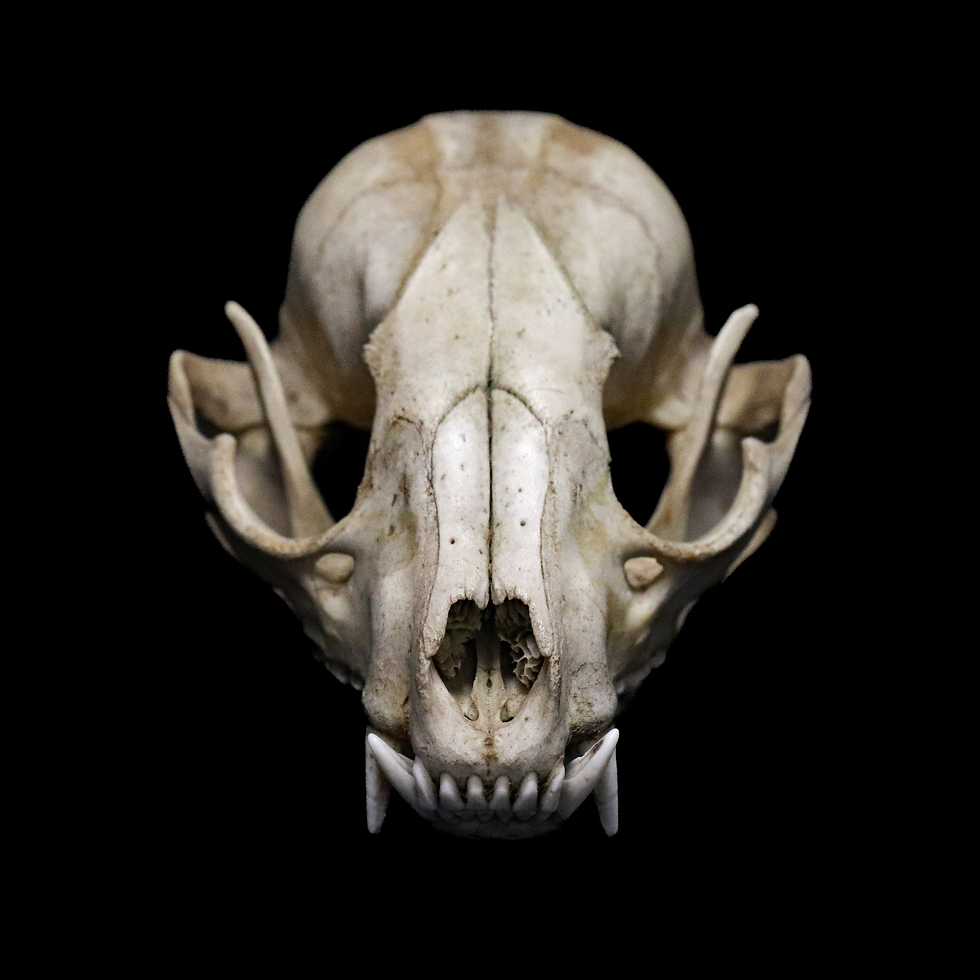Specimen Showcase | Nature’s Bandit Unmasked
- Hong Kong Biodiversity Museum

- Mar 10
- 3 min read
In the twilight hours🌙, as darkness descends upon the field, a mysterious fella emerges from the shadows with its whimsical facial mask. It’s none other than our protagonist - racoon🦝, a fascinating creature that never fails to captivate our attention with its enigmatic behaviour and adaptability. Today, let’s embark on a journey into the life of nature’s most charismatic bandit.

Picture an 80-centimeter-long mammal, with its distinctive black mask around its eyes and ringed tail. No, it’s not Zigzagoon, but 𝘗𝘳𝘰𝘤𝘺𝘰𝘯 𝘭𝘰𝘵𝘰𝘳 (Linnaeus, 1758), commonly known as racoon. Native to North America, the racoons are known for their blackish-grey fur and agile paws🐾. Its scientific name, 𝘗𝘳𝘰𝘤𝘺𝘰𝘯 𝘭𝘰𝘵𝘰𝘳, translates to “washing pre-dog”, which refers to their habit of “dabbling” - dampening their food before consumption. “Animals with mysophobia🧼 (the fear of pathogens)?” You may ask. In fact, research suggests that such humanlike behaviour is only for them to enhance their sense of touch and has nothing to do with hygiene.
When the sun sets and the land is enveloped by the dusk, our little fellow awakens. Primarily nocturnal animals, racoons have extraordinary night vision and tactile sense, which make them exceptionally efficient at feeding and foraging in the dark😋. Their dexterous paws also help them climb trees and scavenge resources in dirt or inside tree cavities. Wearing their iconic domino mask, it makes sense why racoons are often referred to as “nature’s bandits”.

Racoons are often described as opportunistic😎, which is manifested in their flexible and diverse diet. As omnivores, they aren’t picky eaters. Seasonal and environmental changes can be challenging for other species, but for racoons, they can easily adjust their menu accordingly. In spring and summer, they feast on animal-based foods such as crayfish🦐, or seasonal fruits🍊. In autumn and winter, they will turn to seeds and nuts🌰. Their outstanding flexibility in diet and opportunistic characteristics have made racoons almost omnipresent in every habitat, from marshes, and forests, to urban areas where racoons adapt and thrive, often attracted by the smell of garbage🗑️ that they will feed on anytime they can.

While racoons are generally solitary creatures, they do occasionally exhibit social behaviour. The scent produced from the anal gland is often used as a territorial claim as well as identification. Vocalisation🗣️ and posturing are the common communication methods between racoons, especially during mating season to attract females. Racoons may also den together, and the female will give birth🤰🏻 and raise the youth by themselves, usually with 3 to 4 younglings in one litter.

As professional ‘bandits’, racoons’ prowess of course extends beyond physical strength💪🏻. The species is renowned for its intelligence🧠 and adaptability. Raccoons possess innovative problem-solving skills and remarkable learning abilities. Their agile front paws, equipped with sharp claws, enable them to manipulate objects with astonishing precision. They are skilled climbers, able to effortlessly scale trees in search of food or shelter. Most remarkably, they possess impressive learning abilities, learning from adults or siblings🏫 to adapt to the nearby environment. Such a trait comes quite handy when they are settling in a new environment, where skills to exploit new food sources to feed their offsprings and siblings represent a big advantage.

Racoons’ adaptability and cleverness are undoubtedly phenomenal, worthy of a title grander than a mere bandit. Maybe… a conqueror👑? Introduced to Europe in the last century, racoons have been rapidly spreading and invading the local ecosystems. Even far eastern countries like Japan also capitulated to the might of racoons. As an invasive species, racoons radically disturb these native ecosystems and pose a threat to local biodiversity, such as with the Tanuki, also known as the Japanese raccoon dog and which despite its name and resemblance is not related to the raccoon but more to foxes (Canidae). In suburban and urban settings🏙️, they are often found ransacking garbage containers and raiding agricultural land. Even we, humans, can fall victim to the racoon invasion, as racoons can be carriers of diseases and viruses🦠 such as rabies. Governments across the world hence have been arduously containing the population of invasive racoons, however, as this species has been introduced via the pet trade💱, the best approach remains for everyone to understand the risks associated with the introductions of new species and to refrain from such behaviours.
Intrigued by nature’s charismatic bandit? Join us at the Hong Kong Biodiversity Museum to delve into the enigmatic world of this adaptable fella and explore the countless equally engrossing creatures in our exhibition🤩!
Text: Nick Lin




Comments